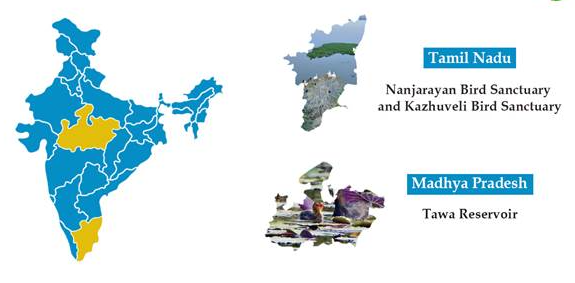India Expands Conservation Efforts: 3 New Ramsar Sites Designated (GS Paper 3, Environment)

Overview:
- India has significantly bolstered its conservation efforts by designating three new wetlands as Ramsar sites, increasing the total number of such sites in the country to 85.
- The newly recognized sites are Nanjarayan Bird Sanctuary and Kazhuveli Bird Sanctuary in Tamil Nadu, and Tawa Reservoir in Madhya Pradesh.
- This expansion reflects India's ongoing commitment to protecting its rich wetland ecosystems.
Why This Matters:
- The Ramsar designation is a prestigious international recognition that highlights the ecological, economic, and cultural importance of wetlands.
- By adding these three sites, India not only acknowledges their global significance but also strengthens its role in global conservation efforts.
- The designation ensures that these areas will receive increased protection and management to preserve their unique ecological functions.
Understanding Wetlands:
Wetlands are diverse environments where water is present at or near the surface, creating habitats that support a wide array of life. According to the Ramsar Convention, wetlands can be natural or artificial and vary widely in their water conditions—from freshwater to saline and from static to flowing. They include:
- Marshes: Wetlands dominated by herbaceous plants.
- Swamps: Forested wetlands.
- Fens: Peat-forming wetlands with a high water table.
- Shallow Marine Waters: Areas up to six meters deep at low tide.
These ecosystems are critical for numerous ecological functions and provide essential services to human societies.
Importance of Wetlands:
- Climate Regulation: Wetlands act as carbon sinks, capturing and storing carbon dioxide from the atmosphere, which helps mitigate climate change. They are among the most productive ecosystems globally, comparable to rainforests and coral reefs in terms of biodiversity and ecological productivity.
- Biodiversity Support: They host a variety of species, from birds and fish to plants and insects. Wetlands like the Sundarbans in West Bengal and Chilika Lake in Odisha are critical habitats for wildlife and support diverse flora and fauna.
- Water Management: Wetlands play a crucial role in water regulation. They help in flood control by absorbing excess water, maintain groundwater levels, and act as natural water purifiers by filtering pollutants from the water.
Wetlands in India:
- India's wetlands cover approximately 152,600 square kilometers, making up 4.63% of the country’s total land area.
- They are categorized into inland-natural wetlands, which account for 43.4%, and coastal-natural wetlands, which make up 24.3%.
- India boasts a rich diversity of wetland types, with Gujarat having the largest area of wetlands, followed by Andhra Pradesh, Uttar Pradesh, and West Bengal.
Conservation Measures:
The Indian government has implemented several initiatives to protect its wetlands:
- National Wetland Conservation Programme (1986): Aimed at conserving and restoring wetland ecosystems.
- National Plan for Conservation of Aquatic Wetlands (2015): Provides a framework for the conservation and management of aquatic wetlands.
- Identification of Over 2,200 Wetlands: For targeted conservation and management efforts.
About Ramsar Sites:
- The Ramsar Convention, established in 1971 in Ramsar, Iran, focuses on conserving wetlands of international importance.
- Ramsar sites are chosen based on criteria that highlight their ecological significance, such as supporting species at critical stages in their life cycles or providing essential habitats for migratory birds.
- India joined the Ramsar Convention in 1982 and now has one of the highest numbers of Ramsar sites in Asia.
New Ramsar Sites in India:
Nanjarayan Bird Sanctuary (Tamil Nadu):
- Originally a water reservoir for irrigation, this site has evolved into a vital bird habitat.
- Located on the Noyyal River, it supports a variety of bird species, including the Eurasian coot and spot-billed duck, and serves as a migratory stopover along the Central Asian Flyway.
- The sanctuary also supports local fishing communities.
Kazhuveli Bird Sanctuary (Tamil Nadu):
- This large brackish water wetland features a combination of salt marshes, mudflats, and shallow waters.
- It is home to globally endangered species such as the black-headed ibis and greater flamingo.
- Kazhuveli plays a critical role in flood control, groundwater recharge, and maintaining the region’s water table.
Tawa Reservoir (Madhya Pradesh):
- Created by damming the Tawa River, this reservoir has become an important wintering ground for migratory birds.
- It provides essential irrigation water for agriculture, drinking water for local communities, and sustains local fisheries, contributing significantly to regional water management.
Conclusion:
- The addition of Nanjarayan Bird Sanctuary, Kazhuveli Bird Sanctuary, and Tawa Reservoir to India’s Ramsar site network is a significant step in enhancing the country’s wetland conservation efforts.
- These sites not only protect crucial habitats for diverse wildlife but also support local communities through their ecological services.
- The Ramsar designation will ensure that these wetlands receive the attention and protection they need to continue providing their vital ecological functions.
- This expansion reflects India's dedication to preserving its natural heritage and contributing to global environmental sustainability.


